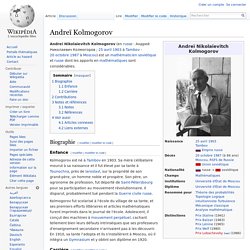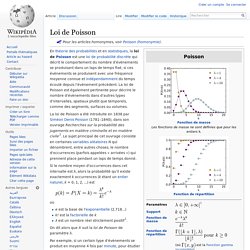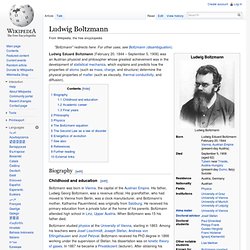

Andreï Kolmogorov. Un article de Wikipédia, l'encyclopédie libre.

Andreï Nikolaïevitch Kolmogorov Andreï Nikolaïevitch Kolmogorov (en russe : Андрей Николаевич Колмогоров ; 25 avril 1903 à Tambov - 20 octobre 1987 à Moscou) est un mathématicien soviétique et russe dont les apports en mathématiques sont considérables. Biographie[modifier | modifier le code] Enfance[modifier | modifier le code] Kolmogorov est né à Tambov en 1903.
Kolmogorov fut scolarisé à l'école du village de sa tante, et ses premiers efforts littéraires et articles mathématiques furent imprimés dans le journal de l'école. Carrière[modifier | modifier le code] Après avoir terminé ses études secondaires en 1920, il suit les cours à l'Université de Moscou et à l'institut Mendeleïev. Après la fin de ses études supérieures en 1925, il commence son doctorat auprès de Nikolaï Louzine, qu’il termine en 1929. Loi de Poisson. Un article de Wikipédia, l'encyclopédie libre.

La loi de Poisson a été introduite en 1838 par Siméon Denis Poisson (1781–1840), dans son ouvrage Recherches sur la probabilité des jugements en matière criminelle et en matière civile[2]. Le sujet principal de cet ouvrage consiste en certaines variables aléatoires N qui dénombrent, entre autres choses, le nombre d'occurrences (parfois appelées « arrivées ») qui prennent place pendant un laps de temps donné. Si le nombre moyen d'occurrences dans cet intervalle est λ, alors la probabilité qu'il existe exactement k occurrences (k étant un entier naturel, k = 0, 1, 2, ...) est où e est la base de l'exponentielle (2,718...)k!
On dit alors que X suit la loi de Poisson de paramètre λ. Calcul de p(k)[modifier | modifier le code] Ce calcul peut se faire de manière déductive en travaillant sur une loi binomiale de paramètres (T; λ/T). Il peut aussi se faire de manière inductive en étudiant sur l'intervalle [0; T] les fonctions. Ludwig Boltzmann. Ludwig Eduard Boltzmann (February 20, 1844 – September 5, 1906) was an Austrian physicist and philosopher whose greatest achievement was in the development of statistical mechanics, which explains and predicts how the properties of atoms (such as mass, charge, and structure) determine the physical properties of matter (such as viscosity, thermal conductivity, and diffusion).

Biography[edit] Childhood and education[edit] Boltzmann was born in Vienna, the capital of the Austrian Empire. His father, Ludwig Georg Boltzmann, was a revenue official. His grandfather, who had moved to Vienna from Berlin, was a clock manufacturer, and Boltzmann's mother, Katharina Pauernfeind, was originally from Salzburg. Boltzmann studied physics at the University of Vienna, starting in 1863. Academic career[edit] In 1869 at age 25, thanks to a letter of recommendation written by Stefan,[1] he was appointed full Professor of Mathematical Physics at the University of Graz in the province of Styria. Kurt Gödel. Kurt Friedrich Gödel (/ˈkɜrt ɡɜrdəl/; German: [ˈkʊʁt ˈɡøːdəl] ( ); April 28, 1906 – January 14, 1978) was an Austrian, and later American, logician, mathematician, and philosopher.

Considered with Aristotle and Gottlob Frege to be one of the most significant logicians in history, Gödel made an immense impact upon scientific and philosophical thinking in the 20th century, a time when others such as Bertrand Russell,[1] A. N. Whitehead,[1] and David Hilbert were pioneering the use of logic and set theory to understand the foundations of mathematics. Gödel published his two incompleteness theorems in 1931 when he was 25 years old, one year after finishing his doctorate at the University of Vienna.
He also showed that neither the axiom of choice nor the continuum hypothesis can be disproved from the accepted axioms of set theory, assuming these axioms are consistent. Life[edit] Childhood[edit] In his family, young Kurt was known as Herr Warum ("Mr. Studying in Vienna[edit] John von Neumann. John von Neumann (/vɒn ˈnɔɪmən/; December 28, 1903 – February 8, 1957) was a Hungarian and later American pure and applied mathematician, physicist, inventor, polymath, and polyglot. He made major contributions to a number of fields,[2] including mathematics (foundations of mathematics, functional analysis, ergodic theory, geometry, topology, and numerical analysis), physics (quantum mechanics, hydrodynamics, and fluid dynamics), economics (game theory), computing (Von Neumann architecture, linear programming, self-replicating machines, stochastic computing), and statistics.[3] He was a pioneer of the application of operator theory to quantum mechanics, in the development of functional analysis, a principal member of the Manhattan Project and the Institute for Advanced Study in Princeton (as one of the few originally appointed), and a key figure in the development of game theory[2][4] and the concepts of cellular automata,[2] the universal constructor, and the digital computer. .
Claude Shannon. Galaxy Dynamics.